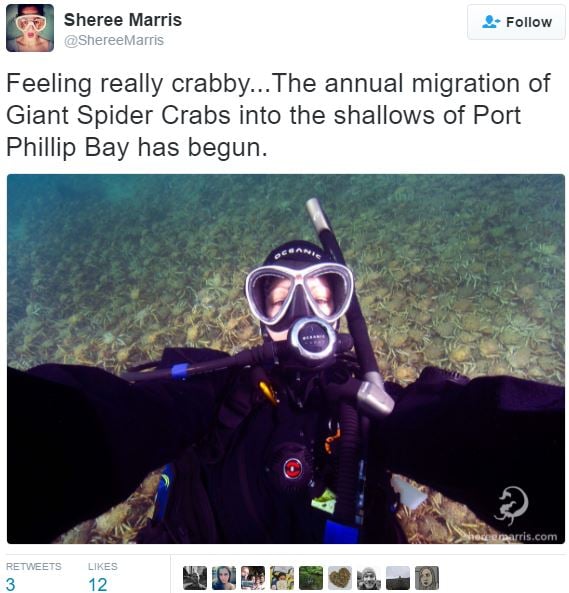An incredible giant spider crab horde was videoed off the coast of Melbourne in Australia as the animals migrated to Australia’s southern shores. We are just a few days from the beginning of winter in the southern hemisphere – at this time of year ocean waters cool, and giant spider crabs migrate.
This horde on the move, filmed by Sheree Marris, an Australian aquatic scientist, had congregated in Port Phillip Bay, a large bay in Southern Victoria where Melbourne is located, covering 480,000 acres (1,930 square kilometres). Half the region, which stretches about 164 miles (264 km), is shallower than 26 feet (8 metres).
Ms. Marris wants to raise awareness of the diversity of marine life that inhabits the waters off southern Australia.
Our beautiful #PortPhillipBay #spidercrab aggregation is happening again & they’re piled 10 high. Story & video: https://t.co/1nU9bYXOqx
— Prof Emma L Johnston (@DrEmmaLJohnston) 18 June 2016
Australian southern shore teeming with life
Ms. Marris said:
“Who would have thought something like this, that is so spectacular, could be happening in Australia on the southern shore.”
Scientists say they are not sure why giant spider crabs congregate in such huge numbers. They believe it is associated with the process of moulting.
When a crab sheds its hard outer shell – something it has to do in order to grow – it is more likely to be caught by cormorants, stingrays and other predators.
Safety in numbers
By gathering together in large numbers, they have a level of protection against being caught, a similar survival tactic is also used by zebras, antelopes and wildebeest in Africa.
 The Nature of Science wrote on Facebook: “We’re loving the media interest surround the Giant Spider Crab footage and imagery we recently captured. Hopefully it will put the spotlight on the unique marine values of the cooler southern shores of Australia.” (Image: facebook.com/thenatureofsciencevideos)
The Nature of Science wrote on Facebook: “We’re loving the media interest surround the Giant Spider Crab footage and imagery we recently captured. Hopefully it will put the spotlight on the unique marine values of the cooler southern shores of Australia.” (Image: facebook.com/thenatureofsciencevideos)
Regarding Port Phillip Bay, Ms. Marris said:
“People think Port Phillip Bay’s a marine wasteland … but this is really unique and it’s really spectacular. Not only is [Melbourne] the most liveable city above the water, it is also the most liveable below the water.”
In an interview with ABC News, Ms. Marris said she had never seen such a colossal horde of spider crabs in her life.
Ms. Marris, a marine life enthusiast who was once winner of the Young Australian of the Year Award, said she swam in a straight line for over 4.5 minutes and there were still thousands of crabs on the sandy shallows below her.
“It was gobsmackingly amazing. I’ve swum maybe a minute-and-a-half to two minutes [in previous years],” she said, and insisted that she had not been swimming deliberately slowly this year.
My chat with Ross and John from 3AW about the march of the giant spider crabs https://t.co/AeTPjGjPfH via @audioBoom
— Sheree Marris (@ShereeMarris) 15 June 2016
Huge crabs
Giant spider crabs, as their name suggests, are huge. Their legs are more than 70cm (27.5 ins) long, while their bodies measure almost 17cm (6.7 ins) across. Their mission is to seek shelter in the safety of the sandy shallows, moult and in many cases mate.
According to The Nature of Science, these creatures are protected by a hard suit of armour, like most crustaceans. However, in order to grow they need to occasionally shed their armour and grow a bigger one.
They shed their armour by secreting a special enzyme that allows the old shell to separate from the underlying skin, while a new, initially soft shell is secreted beneath the old one. They then start absorbing seawater and swell – this causes the old shell to separate.
 Ms. Marris said she had never seen so many giant spider crabs gathered together in one place. (Image: twitter.com/ShereeMarris)
Ms. Marris said she had never seen so many giant spider crabs gathered together in one place. (Image: twitter.com/ShereeMarris)
When one crab begins to moult a chain reaction is set, and all the other animals in the horde start doing the same, virtually simultaneously.
Moulting helps crabs get rid of parasites and other creatures that grow on their shells, including bacteria which weaken their armour.
Video – Giant spider crab aggregation
Watch this colossal horde of giant spider crabs making their way to warmer waters.
